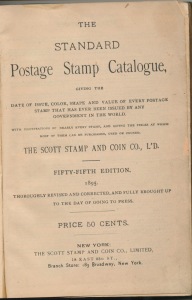Prices for the set of the 2014 Scott catalog have been announced, and they are very high. A full set of eight volumes has a list price of $960, though even Scott themselves discounts them to $720. Still, for an annual catalog this is very high, and though Scott has an Apple iPad app, it is difficult to use, and there is no Android app yet. So most collectors who want the most up to date prices and listings have to buy the expensive print catalogs. Scott catalogs have gone up quite a bit over the years. The 1895 edition, which claimed to list all the postage stamps that had then been issued, had a list price of 50c. So the price of a set of catalogs has gone up 2,000 times in 120 years. To put this in perspective, Ford’s Model T was selling in the early 1920s for $260 and with a low-mid range Ford now in the mid $20,000 range; the price of cars have gone up about a thousand times. But Fords, like the Scott catalog, are quite different animals than they were when they were first made. The current Scott has full color illustrations, lists over half a million more stamps than the 1895 edition did, and has specialized volumes such as the US Specialized and Classic Specialized that never even existed. Prices have gone up tremendously, but the range, scope, size and intent of the catalog have gone up too.
Scott has begun to position themselves more as a reference work than as a collector’s catalog. There is a nod or two in the direction of making the catalog cheaper for collectors (such as putting the Canadian Provinces and the Australian, Italian and German States with their parent countries rather than alphabetically), but full scale geographic and collector area of interest divisions are something that Scott is not interested in. In the late 1980s, Scott made a momentous decision in this regard. For most of the twentieth century, British Commonwealth stamps were listed together in one catalog, and so collectors of British didn’t have to buy all the volumes. Under the direction of Stuart Morrissey, a delightful and dedicated philatelist who died tragically young of cancer leaving a young family, the decision was made to reconfigure the catalogs completely alphabetically. Since then, there have always been suggestions to go back to the old ways and perhaps issue a Scott catalog for all the German area or maybe just China.
For stamp collectors, the high cost of catalogs has not had as much impact on the hobby as many collectors have predicted. First, Scott catalog prices have been very high for years, and collectors have more or less factored this into their hobby. Letters to the editor of stamp magazines have complained about Scott prices almost since the very beginning of stamp collecting. Most collectors today never buy a full set of catalogs, nor do they need to. Most collectors only collect one or two countries, so they buy just the letters the need or the US Specialized. Further, and unfortunately this has been true for many years, the prices of stamps in the catalog, with a few exceptions, have been rising slowly, if at all. This has made a year or two old Scott catalog a good alternative to the cost of a new one. And, the high cost of new catalogs has created a “used catalog” market, where a year or two old catalog can sell for as much as half of their original list price.
Scott sees where all this is going. They have made a decision that slicing off the profitable publishing slivers of their catalog (such as a China stand alone catalog) will cannibalize sales of the main catalog and only postpone, not avoid, the inevitable. And the inevitable is a completely electronic catalog, with no print version at all. If that is the end game, then the current Scott editors and publishers deserve our thanks. They are maintaining a catalog that lists every stamp in the world on an annual basis (and they are the only worldwide catalog to still do this). In the print period, this is a difficult and unprofitable task. But all this information, which would never be assembled again, will be available for collectors in an electronic format where, for future collectors, it will be far cheaper and easier to update and maintain. One almost suspects that the bean counting mandarins who run Scott are unaware of the master plan of their editors.


